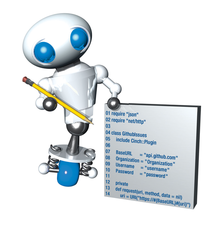Building an IRC Bot with Cinch
Bot Tech

© Lead Image © Chris Modarelli, 123RF.com
Chat rooms aren't just for people. We'll show you how to access an IRC channel using an automated bot.
IRC, the Internet Relay Chat has existed for 20 years, and it is still a popular communication channel in open source projects and businesses. For almost as long, automated bots have listened on IRC channels and responded to user commands. The article shows how IRC bots can make themselves useful by helping you manage tickets and prepare documentation.
Spoiled for Choice
To develop an IRC bot today, you no longer need to learn Tcl to activate the bot ancestor Eggdrop [1]. Frameworks for bots are available in virtually any language (Table 1). Although I focus here on Cinch [2], a framework written in Ruby under the MIT license (Figure 1), you can easily adapt the code examples presented in this article to other languages.
[...]
Buy this article as PDF
(incl. VAT)
Buy Linux Magazine
Subscribe to our Linux Newsletters
Find Linux and Open Source Jobs
Subscribe to our ADMIN Newsletters
Support Our Work
Linux Magazine content is made possible with support from readers like you. Please consider contributing when you’ve found an article to be beneficial.

News
-
Linux Mint 22.3 Now Available with New Tools
Linux Mint 22.3 has been released with a pair of new tools for system admins and some pretty cool new features.
-
New Linux Malware Targets Cloud-Based Linux Installations
VoidLink, a new Linux malware, should be of real concern because of its stealth and customization.
-
Say Goodbye to Middle-Mouse Paste
Both Gnome and Firefox have proposed getting rid of a long-time favorite Linux feature.
-
Manjaro 26.0 Primary Desktop Environments Default to Wayland
If you want to stick with X.Org, you'll be limited to the desktop environments you can choose.
-
Mozilla Plans to AI-ify Firefox
With a new CEO in control, Mozilla is doubling down on a strategy of trust, all the while leaning into AI.
-
Gnome Says No to AI-Generated Extensions
If you're a developer wanting to create a new Gnome extension, you'd best set aside that AI code generator, because the extension team will have none of that.
-
Parrot OS Switches to KDE Plasma Desktop
Yet another distro is making the move to the KDE Plasma desktop.
-
TUXEDO Announces Gemini 17
TUXEDO Computers has released the fourth generation of its Gemini laptop with plenty of updates.
-
Two New Distros Adopt Enlightenment
MX Moksha and AV Linux 25 join ranks with Bodhi Linux and embrace the Enlightenment desktop.
-
Solus Linux 4.8 Removes Python 2
Solus Linux 4.8 has been released with the latest Linux kernel, updated desktops, and a key removal.


